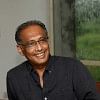
Kazi Khaleed Ashraf
Kazi Khaleed Ashraf is an architect and urbanist, and director-general of Bengal Institute for Architecture, Landscapes and Settlements.
Kazi Khaleed Ashraf is an architect and urbanist, and director-general of Bengal Institute for Architecture, Landscapes and Settlements.
The first experience of the great river Padma is nothing less than overwhelming, and slightly terrifying. I first came to face the mighty river as a young lad in my teens sometime in April of the momentous year of 1971. My first sighting came with two terrors. My father was fleeing Dhaka with the family with the hope of crossing the river to escape the brutal onslaught of the Pakistan army. Arriving at the banks, there was the Padda (Padma) before us with its glorious panorama. It seemed like an oceanic river, with no sight of the other side, and the frightening prospect of crossing it.
Since the 1960s, Prof Abdur Razzaq wielded considerable influence on the academic and literati circle of his time,.
Claiming that Dhaka is an island is an earnest call for an ecological and nature-oriented restoration of the city, and to experience.
Before the construction of the beribadh in the early 1990s, the nameless water body was part of the overflow zone of the Turag River.
It is no wonder that a vast population of Dhaka are generally disgruntled with where they are.
The city is perhaps the greatest innovation carried out by humans. Although nature has been used as an analogy in conceiving the fabric of the city, there is no such thing as the “city” in nature.
The promise of shelter is broken in plain sight
The first experience of the great river Padma is nothing less than overwhelming, and slightly terrifying. I first came to face the mighty river as a young lad in my teens sometime in April of the momentous year of 1971. My first sighting came with two terrors. My father was fleeing Dhaka with the family with the hope of crossing the river to escape the brutal onslaught of the Pakistan army. Arriving at the banks, there was the Padda (Padma) before us with its glorious panorama. It seemed like an oceanic river, with no sight of the other side, and the frightening prospect of crossing it.
Since the 1960s, Prof Abdur Razzaq wielded considerable influence on the academic and literati circle of his time,.
Claiming that Dhaka is an island is an earnest call for an ecological and nature-oriented restoration of the city, and to experience.
Before the construction of the beribadh in the early 1990s, the nameless water body was part of the overflow zone of the Turag River.
It is no wonder that a vast population of Dhaka are generally disgruntled with where they are.
Mir Mosharraf Hossain Hall should be retained and restored.
The city is perhaps the greatest innovation carried out by humans. Although nature has been used as an analogy in conceiving the fabric of the city, there is no such thing as the “city” in nature.
Described as the doyen of Bangladesh’s architecture, Muzharul Islam introduced modernism in the country as well as the highest ideals of the craft.
The city, the one that we want to arrive at, remains illusory